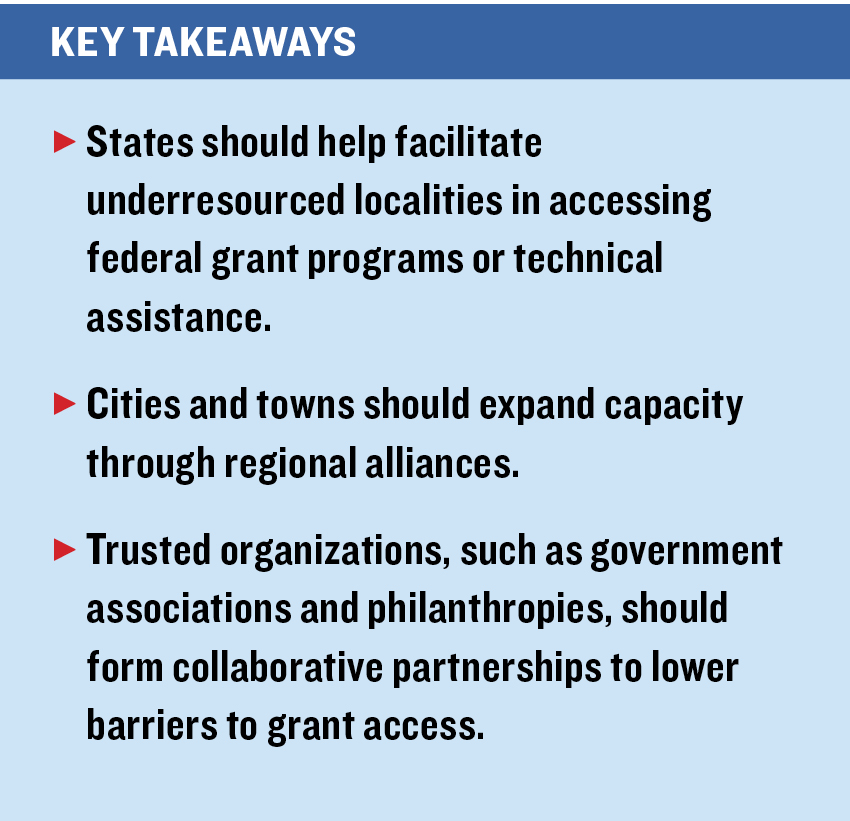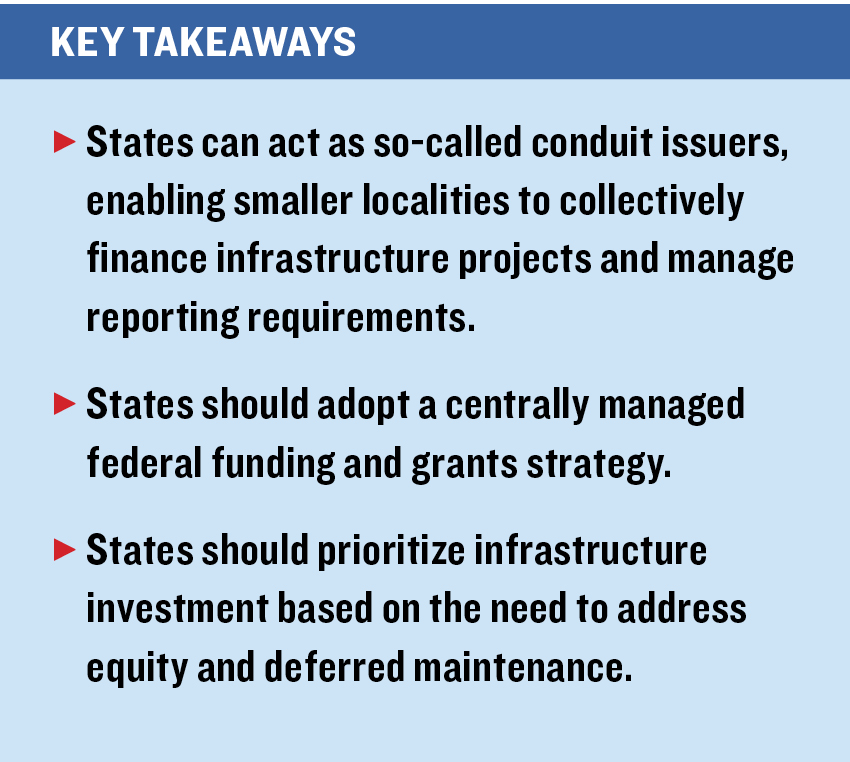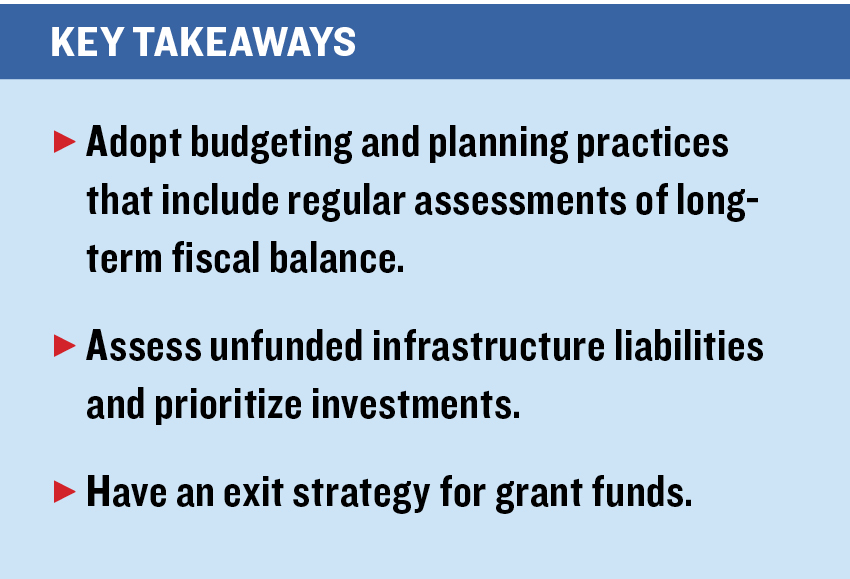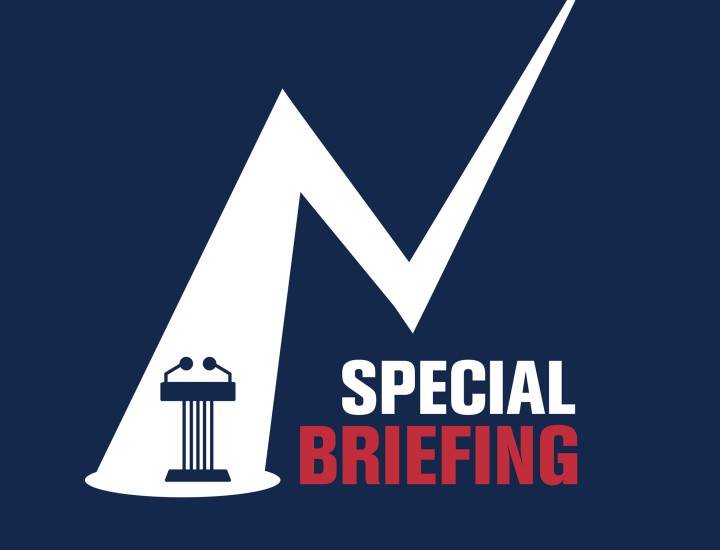
Effective Fiscal Federalism
EXECUTIVE SUMMARY
AS MORE THAN $5 TRILLION IN FEDERAL pandemic emergency aid to the US economy comes to an end, states and localities are confronting immense challenges that are increasing in urgency, complexity, and cost, including closing the nationwide housing gap, ameliorating the impact of climate change, and rebuilding deteriorating infrastructure.
Yet there are reasons for optimism. The COVID-19 pandemic and funding response over the past four years pushed states, localities, and federal agencies to collaborate and communicate in ways many government stakeholders and policymakers had not experienced. It was an unplanned national experiment that yielded many lessons about intergovernmental relationships. Now, practitioners at all levels have an opportunity to institutionalize the promising practices that have emerged. The pandemic years also reinforced the need for states and localities to deploy proven best-practice budgeting strategies to ensure fiscal health and uninterrupted service delivery over the long term.
Lessons and opportunities coming out of the pandemic years was the focus of the second Richard Ravitch Public Finance Initiative Symposium, convened by the Volcker Alliance and hosted by The Pew Charitable Trusts in Washington, DC, on September 17, 2024. Named for the late New York State Lieutenant Governor and Alliance Director, the Symposium brought together current and former senior federal, state, and local government officials, government association leaders, municipal bond market investors, and policy experts to discuss lessons learned during the pandemic and propose solutions to improve the federal-state-local fiscal relationship. This report summarizes and expands on key themes that emerged through the Symposium’s discussions.
INTRODUCTION
THE GLOBAL COVID-19 PANDEMIC in 2020 exacerbated longstanding policy challenges for US state and local governments while also bringing to the fore unanticipated ones. As the pandemic recedes further into the rearview mirror, stakeholders are evaluating the many innovative practices that emerged during these startling and uncharted times, and exploring prospective opportunities for sustainable budgeting and fiscal management on the part of the federal government, states, and localities.
While the federal response to the challenge of COVID-19 included an unprecedented $5 trillion in aid to individuals, companies, and state and local governments, this extraordinary sum came alongside the $1 trillion in annual federal funding states and localities already receive directly to help defray costs for infrastructure, education, public safety, and Medicaid, the health care program for low-i come Americans. Hundreds of billions of dollars in grants and other funding available via the 2021 Infrastructure Investment and Jobs Act (IIJA) and the 2022 Inflation Reduction Act (IRA), will continue to flow into the next decade. Government practitioners at all levels must seize upon these pandemic-era opportunities before they permanently fade away.
Such opportunities—and longer-term strategies—were the focus of the second Richard Ravitch Public Finance Initiative Symposium, convened by the Volcker Alliance and hosted by The Pew Charitable Trusts in Washington, DC, on September 17, 2024. The Symposium marked the final year of the Richard Ravitch Public Finance Initiative, which was named for the late New York State Lieutenant Governor, Alliance Director, and key actor in the reconstruction of the finances of New York City after its near-bankruptcy in 1975. His role in the city’s turnaround, sparked in no small measure by $2.3 billion in federal emergency loans, left Mr. Ravitch with a passion for promoting sustainable fiscal practices at all levels of government, as well as for educating congressional and Executive Branch leaders about the imperative of heightened federal oversight of state and local budgets and finances.
The September Symposium reflected these passions. To help set the agenda for the event, the Alliance conducted detailed interviews with more than twenty senior federal, state, local, and financial industry officials to discuss lessons learned during the pandemic and generate concrete proposals to improve the federal-state-local fiscal relationship. Their observations and suggestions were the starting point for a full day of facilitated discussions, in which Symposium participants explored innovative and collaborative ways to deploy and manage federal funding to states and localities. These included proven and emerging policy tools to support fiscal sustainability, infrastructure funding, and strengthen state and local government capacity. Attendees, some of whom are quoted anonymously in this report, spoke candidly about their experiences and perspectives.
The collaboration generated four incisive categories of recommendations. They are aimed
at catalyzing federal action and improving state and local budget practices that present looming
risks to the federal system and economy.
BUILDING CAPACITY
 STATES AND LOCALITIES that think strategically about their long-term goals and how to afford them are creating a more sustainable path for budgets that can withstand economic volatility and quickly capitalize on new opportunities. But many local governments, particularly smaller ones, often lack the staffing and resources to engage in long-range, community-driven planning. The American Rescue Plan Act of 2021 (ARPA) placed a spotlight on these capacity issues in many localities. Some received more federal
STATES AND LOCALITIES that think strategically about their long-term goals and how to afford them are creating a more sustainable path for budgets that can withstand economic volatility and quickly capitalize on new opportunities. But many local governments, particularly smaller ones, often lack the staffing and resources to engage in long-range, community-driven planning. The American Rescue Plan Act of 2021 (ARPA) placed a spotlight on these capacity issues in many localities. Some received more federal
grant money than they ever had before. For many, the reporting requirements alone were daunting, never mind the idea of leveraging that money toward a long-term strategic investment.
With significantly more federal funding still coming through IIJA and IRA, there is concern that many localities will lack the resources and technical knowledge required to apply for federal grant opportunities that could help them tackle long-term systemic issues. While public colleges and universities have often been a resource to governments, adding to their capacity to research and conduct pilot projects or other programs to improve outcomes, weakening enrollment and budget deficits may limit these types of activities.
In response to the longstanding complaints around the challenges governments experience navigating federal funding opportunities, the White House Office of Management and Budget (OMB) issued new guidelines effective in October 2024. In particular, OMB announced reforms to the Uniform Guidance rules that govern federal grantmaking. The new rules ease some of the reporting burden by revising financial thresholds. They also mandate dramatic changes aimed at simplifying the grants process to increase equity across all levels of government. Among the reforms are reducing the number of federal agency approvals that grant recipients must receive before being allowed to spend money; streamlining issuance of federal Notices of Fund Opportunities (NOFOs); and confirming that recipients of certain awards may keep unspent funds at the end of a project.
Ideas for Building Capacity through Collaboration
States and municipalities—especially those communities with limited resources—may be better able to identify specific needs and federal programs to address them if they work together. States can help by providing financing and building regional consortiums, while cities and towns with common needs may want to consider ad hoc partnerships to address specific concerns. Nonprofit organizations and universities also can contribute by providing technical assistance, regional convenings, and access to federal grant data.
States Should Be Facilitators
States are in a unique position to act as a liaison between smaller, underresourced localities and the federal government. Many states, for example, offer technical assistance either directly or via grants to local governments that successfully apply. But some states have gone further to assist smaller governments. For example, the Vermont Bond Bank, a fifty-year-old state institution, currently has $532 million in outstanding low-cost infrastructure loans to localities that otherwise may not be able to sell municipal bonds on such advantageous terms.
State officials’ 30,000-foot view of needs and opportunities across several regions also gives them a framework for coordinating federal grant efforts across multiple government entities. A centralized grants office focused on this task can also weed out repetition, such as two state agencies or two adjacent localities unknowingly applying for the same federal grant. One well-run model of this type of coordination was the Maryland Governor’s Grants Office. From 2004 to 2017, the office coordinated agency federal grant activities; provided training and technical assistance to state and local government agencies and nonprofits; and measured, tracked, and disseminated federal funding data. The office has since shifted its focus to federal relations.
Smaller Cities Should Band Together
Smaller governments can form consortia to share challenges and leverage resources to access funding or financing. For example, multistate and multicity/county initiatives, such as the New England Regional Project on Economic Development, based at the University of Connecticut Hartford campus and funded by a $500,000 US Department of Agriculture grant, aims to address challenges faced by poorer cities in the region related to income, skills, and health disparities. Symposium attendees agreed that Congress should consider providing additional financial incentives for such regional organizations.
Attendees also discussed private initiatives to pool resources, such as the Local Infrastructure Hub, which is backed by the National League of Cities, US Conference of Mayors, and several large nonprofit organizations, including Bloomberg Philanthropies and the Ford Foundation. One participant noted that the Hub offers local governments access to a database of about 5,000 federal grants, staff that can translate federal NOFOs into plain English; and workshops for local government leaders to develop skills needed to apply for federal grants. In addition, one participant also cited more ad hoc partnerships among cities. In one such partnership, the Pennsylvania municipalities of Mt. Lebanon and Dormont, home to fewer than 45,000 people combined, pooled resources to purchase financial management and grant software that would have been too expensive for each to buy on their own.
Leverage Trusted Networks
While several states, including Connecticut, have their own intergovernmental offices that engage with state-local issues, no national organization is focused on the issue of local-state-federal coordination.
For many years, however, the Advisory Council on Intergovernmental Relations (ACIR) did just that. From its creation under federal law in 1959 to its termination in 1996, ACIR built and fostered relationships across all levels of government. Bringing it back in full or modifying it to focus on one challenge (such as mental health) could help strengthen understanding and coordination and provide a blueprint for building a more cohesive system for all levels of government. Previous efforts to revive the council have not taken hold. But the direct line to federal agencies that many local and state officials experienced during the first year of the pandemic shows how critical intergovernmental cooperation is.
“Some of those relationships that have been built over the past three to five years, from
local, state, and federal—they’re gold,” said one symposium attendee. “We really dug in and
identified not only some of the structures of the programs, but also enhanced our capacities
at the local and state level on how to work together.”
More recently, the National Academy of Public Administration’s Center for Intergovernmental Partnerships, which has supported research and collaboration on learnings from pandemic-era funding, launched its Grand Challenges in Public Administration campaign. The initiative identifies specific ways that federal agencies, states, and localities should collaborate in policy and program design to achieve better outcomes across society’s biggest intergovernmental challenges.
Resources for Building Capacity
- “OMB Uniform Guidance Final Rule: Significant Improvements to Federal Grants Rules”
- “An ACIR Perspective on Intergovernmental Institutional Development”
- Local Infrastructure Hub
- Simpler Grants.Gov
- Simpler NOFOs
- “HHS, Treasury, and Interior Departments and the Executive Office of the President Aim
to Reduce Administrative Burden for Tribal Grant Recipients” - NJ Treasury Grants Management Office CDFA Grant Writing Assistance Program
- Truth and Integrity in State Budgeting: Preparing for the Storm
- A Cloudy Crystal Ball: Pandemic Challenges Highlight Need for Budget Relief Valves
- On the Edge: Balancing Budgets in a Postpandemic World
INNOVATIVE FINANCING CAN FUTUREPROOF INFRASTRUCTURE AGAINST CLIMATE RISK AND OTHER CHALLENGES
 INFRASTRUCTURE planning and investment is central to economic growth but many places struggle to find access to affordable financing or grant funding. Meanwhile, long-term planning around infrastructure debt—particularly in terms of combating climate change—remains murky. Financial disclosure related to climate risks isn’t mandated, and what reporting there is can vary wildly across governments. Centralized assessment and management of infrastructure needs are sorely lacking across states and localities, and adequate funding for projects, particularly for smaller governments and marginalized communities, is difficult to access.
INFRASTRUCTURE planning and investment is central to economic growth but many places struggle to find access to affordable financing or grant funding. Meanwhile, long-term planning around infrastructure debt—particularly in terms of combating climate change—remains murky. Financial disclosure related to climate risks isn’t mandated, and what reporting there is can vary wildly across governments. Centralized assessment and management of infrastructure needs are sorely lacking across states and localities, and adequate funding for projects, particularly for smaller governments and marginalized communities, is difficult to access.
As technological advancements, aging infrastructure, remote work trends, population shifts, climate change and natural disasters create different and more expensive infrastructure needs, credit rating agencies, which assess the risks of municipal bond defaults, are pointing out the need to take on debt. After Hurricane Helene wreaked havoc upon Tennessee and western North Carolina in October 2024, the credit rating firm S&P Global noted the “shift to inland damage from where the storms make landfall could require greater storm preparedness in such areas, adding to the region’s need for storm hardening. Although federal and state disaster relief funds may partly offset the expenditures, costs for infrastructure investments could require additional debt and pressure issuers’ fixed costs.”
Generative artificial intelligence is already transforming commercial real estate management; many believe it can similarly support state and local capital planning and decision-making efforts by identifying the areas with the greatest need and risk and where investments can go the furthest. The Federal Data Transparency Act, which obliges state and local government bond issuers to file structured digital financial reports beginning in 2027, also poses an opportunity for states, counties, and cities to strengthen their data collection and reporting methods.
Ideas for Creative Financing to Drive Futureproofing
State and local policymakers have opportunities to explore creative financing and use federal programs to increase equitable access to grant funds, particularly for infrastructure projects.
Establish State Bond Banks
Though only thirteen states have authorized bond banks, these lenders can play a bigger role in infrastructure financing. As a so-called conduit issuer, bond banks can help smaller localities access affordable financing and make borrowing for infrastructure and other assets more equitable. A recent Brookings Institution paper on bond banks has found that they are accustomed to navigating a complex infrastructure landscape and can help advance long-term infrastructure goals.
Notably, Vermont Bond Bank’s Municipal Climate Resilience Fund offers low-cost loans to communities for rebuilding after a disaster while the Virginia Resource Authority's Resilient Virginia Revolving Fund provides affordable adaptation financing.
Leverage the IIJA’s State Infrastructure Coordinator
The IIJA encouraged governors to appoint a state infrastructure implementation coordinator to oversee investments in transportation, water, broadband, and energy and to facilitate coordination with federal agencies and other governments. Michigan took that a step further by establishing a state infrastructure office responsible for marshalling resources, implementing a cohesive strategy across state government, and partnering with local governments, federal agencies, and other stakeholders.
In Arizona, the appointed infrastructure coordinator launched an IIJA Task Force focused on projects that promote broadband expansion, workforce development, cybersecurity, healthy forests, and energy. It also identifies grant opportunities and provides federal grant support and resources to localities.
Adopt Long-term Capital Plans
Multiyear capital planning helps governments address current and longer-term infrastructure investments by identifying needs, funding options, and potential budget impacts years ahead of time. The Government Finance Officers Association, which recommends the practice, notes that a long-range plan is a critical component of economic growth and financial stability. Illinois’ $45 billion capital plan, the largest capital program in state history, plots out specific investments over a six-year period and provides updates on the progress by county. Idaho, one of the fastest-growing states over the past fifteen years, conducts annual workshops and listening sessions for its seven-year Transportation Investment Program to help guide its project selection and prioritization.
By evaluating assets based on their life cycles, prioritizing funding based on needs and policy priorities—such as equity—and plotting out the fiscal strategy, long-term capital plans form a blueprint for state and local government financing needs and federal grants strategy. If new opportunities appear, the difficult work of assessing need and costs would be largely complete.
Symposium participants said that governments should be rewarded for incurring “protective debt” to minimize or mitigate future fiscal risks such as investing in adaptation or resiliency. “We recognize there are these megatrends that are changing the world right now,” said a participant. “The climate change and the physical risks that are coming are different.”
Resources for Innovative Financing
- State Bond Banks: the Best Kept Secret in Infrastructure Finance
- Infrastructure Investment and Jobs Act (IIJA) Implementation Resources
- IIJA Implementation Resources
- “Best Practices: Multi-Year Capital Planning”
- “Early Planning Can Curb Costs, Climate Stress on Neglected Infrastructure”
- “New Inclusive Development Models Help Ensure Equitable Infrastructure Investments”
- P3 Value Webinars: Financing of Highway Public-Private Partnership Projects
- Federal Highway Administration Center for Innovative Finance Support
MANAGING FEDERAL FUNDS EFFECTIVELY
 THE FEDERAL government’s decision in 2021 to distribute $350 billion in ARPA fiscal relief funding directly to state, local, tribal, and territorial governments was a key move in reducing red tape during the pandemic response and got money out quickly to where it was needed. However, the enormity of those grants also presented a management and reporting challenge for public finance officials, especially those in smaller localities with limited administrative capacity.
THE FEDERAL government’s decision in 2021 to distribute $350 billion in ARPA fiscal relief funding directly to state, local, tribal, and territorial governments was a key move in reducing red tape during the pandemic response and got money out quickly to where it was needed. However, the enormity of those grants also presented a management and reporting challenge for public finance officials, especially those in smaller localities with limited administrative capacity.
Despite the influx of federal funding, government budgeting and planning in general are becoming more difficult as political and environmental risks loom large. Increasing political polarization and the rising frequency of federal shutdown threats create short-term volatility and longer-term uncertainty that make it difficult for state and local public finance officials to plan for the years ahead. Challenges such as increasingly extreme weather events, the housing crisis, and health care remain costly and complicated problems with no quick fix—even with the additional federal grant and funding opportunities.
Meanwhile, the investment opportunities via the IIJA and the IRA are challenging to tap into and manage. “One of the big challenges we’re seeing is that there are so many agendas being brought to bear on the federal funding and it just adds an enormous amount of paperwork and complexity to even a very simple grant,” another participant said during the Symposium. Electric vehicle charging grant applications, for example, require detailed documentation, including various environmental assessments, proof that prevailing wages will be paid, and procurement requirements. “A lot of local governments took passes on some of these federal programs because of this complexity,” the participant said.
Ideas for Bolstering the $1 Trillion Relationship
States struggle perennially to leverage funds effectively and put in place practices that support sustainable financing and budgets. While the pandemic surfaced new opportunities to strengthen practices, these trusted strategies remain important:
Adopt Budget Stress Testing
For states and localities, budget stress tests estimate the magnitude of risks posed by adverse events such as recessions or an economic shock. A stress test identifies one or more potential scenarios that could threaten budgetary balance; analyzes the potential effects of these scenarios on the budget; and compares the negative effects with available or needed contingencies—such as rainy day funds—for addressing them.
According to a Pew Charitable Trusts research brief, “Tools for Sustainable State Budgeting,” thirteen states have conducted a budget stress test since 2018. The exercises helped policymakers plan for recessions, avert or limit fiscal emergencies, and keep long-term priorities on track. They informed decisions about reserve balances and other budgetary policy responses to economic downturns.
Forecast for the Long Term
Long-term budget assessments, a practice advocated by the Alliance in its Truth and Integrity in State Budgeting report cards for 2015-19, project revenue and spending several years into the future to show whether and why states may face chronic budget deficits. Fifteen states have conducted such an exercise since 2018 and, for some, the practice has helped identify a structural deficit years before the shortfall shows up in the annual budget. In New Mexico, for example, where Pew noted that after a 2022 long-term assessment found that declining oil and gas production would eventually lead to a persistent deficit, “lawmakers in the state directed hundreds of millions of dollars to endowments and trust funds designed to provide ongoing revenue to help close the gap.”
Integrate Budgeting and Strategic Planning
Embedding fiscal planning within a strategic goal-setting process creates more realistic terms and expectations around those long-term priorities while also ensuring that annual budgets contribute to big-picture initiatives such as infrastructure improvements, climate resilience, or workforce development. One way of doing so is linking budget allocations to specific strategic outcomes. For example, Albuquerque, New Mexico’s, strategic goals dashboard provides regular progress updates on core objectives alongside the annual budget for programs related to those goals.
Have an Exit Strategy for Temporary Funding
Grantors, such as the federal government and states, should create a framework around one time funding that includes an exit strategy for recipients. In Idaho, this practice is embedded in the state interagency grants process. The state Division of Financial Management requires that agencies applying for grants include a letter that outlines how they will continue programs without state grant support or wind down operations responsibly if the grant expires.
Measure Unfunded Infrastructure Liabilities
Though most states and localities have capital plans that address expected spending, these documents don’t estimate the cost of inaction. Unfunded infrastructure liabilities such as deferred maintenance and funding shortfalls are not universally tracked, yet understanding the scope of this debt is critical to long-term planning. While there is no comprehensive official data on state deferred maintenance liabilities, federally mandated state Transportation Asset Management Plans offer a partial view. By 2031, Michigan estimates it will be $15 billion behind in the investment needed to keep road pavement in a state of good repair.
This level of data collection and disclosure can help policymakers make more informed, evidence-based decisions about their infrastructure spending needs and priorities. Meanwhile, the Governmental Accounting Standards Board, whose pronouncements govern state and local financial reporting, is turning up the pressure with a new project aimed at more detailed disclosures of deferred infrastructure maintenance costs. Among other things, the project is weighing requirements such as a ten-year schedule of maintenance expenses and a percentage measure of the remaining life of capital assets.
Resources for Improving Budgetary Policies
- Tools for Sustainable State Budgeting: Long-Term Budget Assessments and Stress Tests Promote
Fiscal Resilience - Pandemic Aid: How States Safeguarded Against Future Budget Challenges
- America’s Trillion Dollar Repair Bill: Capital Budgeting and the Disclosure of State Infrastructure
Needs - “Why is Everything Crumbling? A Look at Deferred Maintenance”
- “‘Lost Decade’ Casts a Post-Recession Shadow on State Finances”
- “Fiscal 50: State Trends and Analysis”
- Truth and Integrity in State Budgeting: Preparing for the Storm
- A Cloudy Crystal Ball: Pandemic Challenges Highlight Need for Budget Relief Valves
- On the Edge: Balancing Budgets in a Postpandemic World
CONCLUSIONS AND RECOMMENDATIONS
EVEN AS BILLIONS OF FEDERAL DOLLARS have flowed into the economy and government coffers since 2020, states and localities face ever-increasing political, economic, environmental and capacity challenges that threaten their long-term fiscal health and stability. While the COVID-19 pandemic exacerbated these challenges, it also sparked creative solutions and novel opportunities. Symposium participants found broad agreement on these foundational principles:
- It is critical to adopt sustainable budgeting practices that help governments manage
against fiscal risks and plan for long-term investments; - Access to federal funding and other means of affordable financing should be bolstered
through forging alliances, building consortiums, and improving communication and
coordination across all levels of government; and - States, localities, and the US government should surface new and more equitable ways
to plan and pay for infrastructure investments through innovative financing and a more
cohesive approach to federal grant management.
As pandemic-era emergency funding fades, the ideas and recommendations discussed at the Symposium and in this report can help guide public officials and government stakeholders in strengthening their communities and preparing for the uncertainties that lie ahead. Sound budgeting practices, long-term planning, clear communication, and a collaborative mindset across all levels of government can all build upon each other to create momentum and lay the groundwork for sustainable growth and stability.
APPENDIX
Richard Ravitch Public Finance Initiative Fall 2024 Symposium Attendees
- Nancy Augustine, Director, Center for Intergovernmental Partnerships, National Academy of Public Administration
- Dale Bell, Deputy Assistant Secretary, Department of Health and Human Services
- Carolyn Bourdeaux, Consultant, Three Irons Consulting, LLC
- Beverly Bunch, Professor, University of Illinois Springfield, School of Public Management and Policy
- Geoff Buswick, Managing Director, S&P Global
- Graham Dowd, Program Associate, The Volcker Alliance
- David Draine, Principal Officer, The Pew Charitable Trusts
- Sara Dube, Director, Fiscal and Economic Policy, The Pew Charitable Trusts
- Patrick Early, Senior Policy Analyst, US Department of Treasury, Office of Public Finance
- Liz Farmer, Officer, Fiscal 50, The Pew Charitable Trusts
- Mark Funkhouser, President, Funkhouser & Associates
- Michael Gaughan, Executive Director, Vermont Municipal Bond Bank
- Teresa Gerton, President and CEO, National Academy of Public Administration
- William Glasgall, Senior Director, Public Finance, The Volcker Alliance
- Gary Grippo, Deputy Assistant Secretary for Public Finance, US Department of Treasury
- Marcia Howard, Executive Director, Federal Funds Information for States
- Kil Huh, Senior Vice President, Government Performance, The Pew Charitable Trusts
- Shelby Kerns, Executive Director, National Association of State Budget Officers
- Megan Kilgore, City Auditor, Columbus, Ohio
- Andrew Kleine, Managing Director, Government & Public Sector, Ernst & Young
- Abhinay Lingareddy, Former intern, The Volcker Alliance
- Sara Mogulescu, President, The Volcker Alliance
- Peter Muller, Senior Officer, The Pew Charitable Trusts
- Mary Murphy, Senior Director, The Pew Charitable Trusts
- Abhi Nemani, Senior Vice President, Product, Euna Solutions
- Scott Pattison, Director, Policy and Research, Multistate Tax Commission
- Samuel Pittman, Associate, Managing Fiscal Risks, The Pew Charitable Trusts
- Mark Schmidt, Head of Municipal Strategy, Morgan Stanley
- Ariel Sussman, Director, Public Affairs, SKDK
- Rebecca Theiss, Manager, The Pew Charitable Trusts
- Zoe Walker, Legislative Assistant, Office of US Representative Earl Blumenauer (D-OR)
- Lisa Washburn, Managing Director, Municipal Market Analytics
- Kate Watkins, Associate, The Pew Charitable Trusts
- Leah Wavrunek, Senior Policy Analyst, National Association of State Budget Officers
- Erin Weinstein, Executive Vice President, SKDK
- Antonio Weiss, Director, the Volcker Alliance; Research Fellow, Harvard University, John F. Kennedy School of Government
- Kathryn White, Director of Budget Process Studies, National Association of State Budget Officers
- Noah Winn-Ritzenberg, Director, Research and Impact, The Volcker Alliance
- Fatima Yousofi, Senior Officer, The Pew Charitable Trusts
- Teryn Zmuda, Chief Research Officer and Chief Economist, National Association of Counties
ACKNOWLEDGMENTS
THE VOLCKER ALLIANCE would like to thank The Pew Charitable Trusts for their partnership in this project and particularly to writer Liz Farmer for her significant contributions to this paper. The ideas generated by the Symposium would also not have been possible without its participants. We thank them deeply for giving this Initiative many hours of their time and expertise.
These proceedings and the second Richard Ravitch Public Finance Initiative Symposium were made possible in part by generous support by the late Richard Ravitch, the Volcker Family Foundation, and the Volcker Alliance.
The event’s organizers thank the staff of SKDK for their assistance in planning, organizing, and producing the symposium.
We would also like to acknowledge the following government offices and private organizations for their contributions during the symposium planning stages and during the symposium:
- Alvarez & Marsal
- City of Chicago
- City of Columbus, Ohio
- Ernst & Young
- Euna Solutions
- Federal Funds Information for States
- Funkhouser & Associates
- Government Finance Officers Association Federal Liaison Center
- Harvard University, John F. Kennedy School of Government
- Idaho Division of Financial Management
- Milken Institute
- Morgan Stanley
- Multistate Tax Commission
- Municipal Market Analytics
- National Academy of Public Administration
- National Association of State Budget Officers
- National Association of Counties
- Office of the Dallas County Administrator
- Office of the New York State Comptroller
- Office of US Representative Earl Blumenauer (D-OR)
- Office of US Senator John Cornyn (R-TX)
- Office of US Senator Gary Peters (D-MI)
- Ohio Office of Budget and Management
- State of Utah Legislature
- S&P Global Ratings
- Three Irons Consulting, LLC
- US Department of Health and Human Services
- US Department of the Treasury
- US Department of Transportation
- University of Illinois Springfield School of Public Management and Policy
- University of Utah
- Vermont Municipal Bond Bank
© 2024 VOLCKER ALLIANCE INC.
Published November, 2024
The Volcker Alliance Inc. hereby grants a worldwide, royalty-free, non-sublicensable, non-exclusive license to download and distribute the Volcker Alliance paper titled Resilient State and Local Finance and Effective Fiscal Federalism (the “Paper”) for non-commercial purposes only, provided that the Paper’s copyright notice and this legend are included on all copies.
This paper was published by the Volcker Alliance as part of its Richard Ravitch Public Finance Initiative. The views expressed in this paper are those of the authors and do not necessarily reflect the position of the Volcker Alliance. Any errors or omissions are the responsibility of the authors.
Don Besom, art director.

